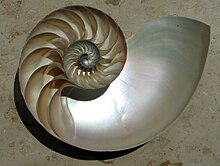Phragmocone

The phragmocone is the chambered portion of the
In most nautiloids and ammonoids, the phragmocone is a long, straight, curved, or coiled structure, in which the camarae are linked by a siphuncle which determines buoyancy by means of gas exchange.
Despite this benefit, such a large shell adds to the mass of the animal, and hence is disadvantageous in catching fast-moving prey. Some nautiloids, such as the
Fossil record
Being the only biomineralised part of most cephalopods, the phragmocone is typically the only part to enter the fossil record. It is sometimes infilled with sediment, with sediment presumably getting in through the siphuncle.[1] There are occasions where trilobites have been preserved within phragmocones, presumably where they crawled in for refuge.[2]
References
- .
- doi:10.1080/002411601300068251.)
{{cite journal}}: CS1 maint: multiple names: authors list (link



